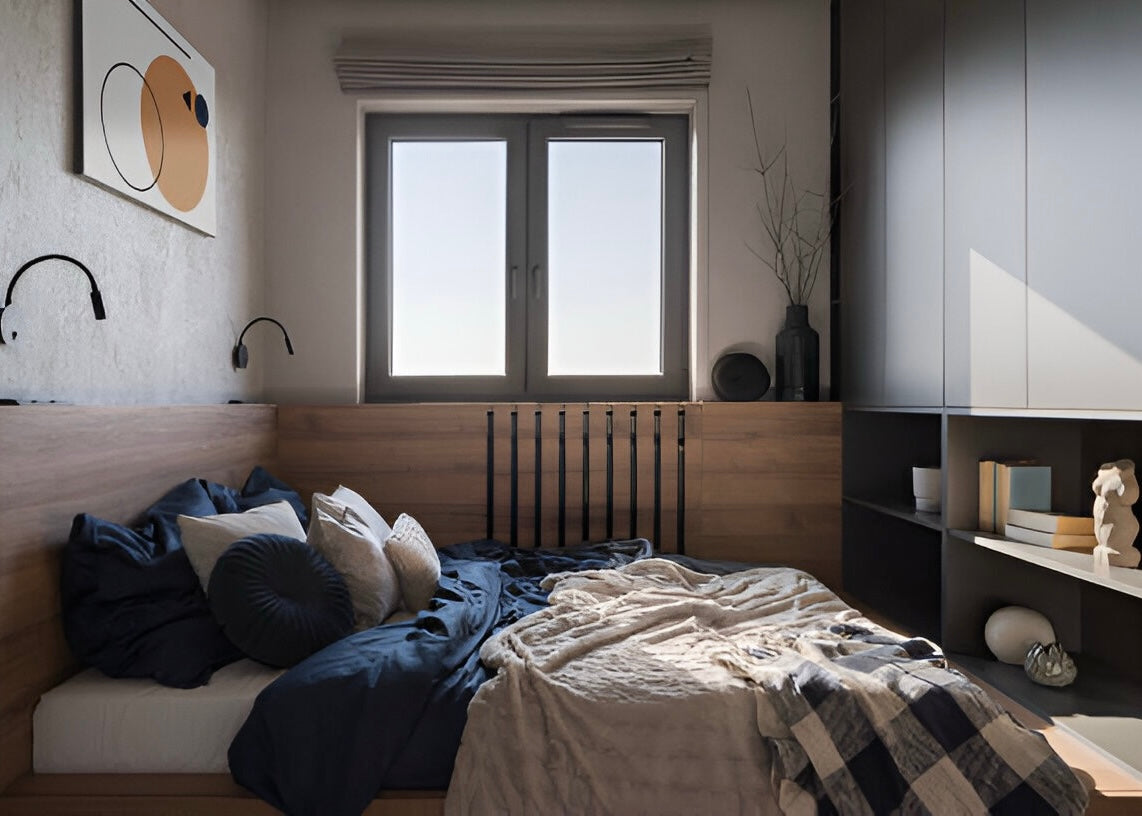No more tunnel vision: Here's how to finally make a narrow living room cozy
Hand on heart: Do you walk into your living room and feel a bit like you're at a bowling alley? Walls to Left and right that seem to come towards you and a distant end that sinks into the semi-darkness? You are not alone. The "tube room" is an architectural classic - and one of the biggest challenges for anyone who wants a cozy, inviting home.
Most fail because they are fighting with the wrong weapons. They try to "slay" the room with a single, powerful lamp or line up lights like on an airfield runway. The result? The tunnel effect is only amplified. But what if we told you that your long, narrow room is not your fate, but your greatest opportunity? With the right lighting concept, you can visually widen it, give it character and transform it into a succession of beautiful, homely zones. This is not just an article with a few tips. This is your complete roadmap.
Your way from a tube room to an oasis of well-being:
The fundamental error in thinking: why longitudinal lighting is your enemy
Before we hang a single lamp, we need to understand the core problem. A long, narrow room looks like a tunnel because our eye is inevitably led along the long walls to the end of the room. Anything that emphasizes this long axis makes it worse.
And what do most people do? They hang a series of spotlights along the ceiling or a long track lengthwise. This is a "light highway" that makes the eye shoot even faster to the end of the room. The room appears even longer, even narrower. Our aim must be the exact opposite: We must break the longitudinal axis and emphasize the transverse axis.
The core strategy: break the tunnel with light zones
Say goodbye to the idea of lighting the room as a whole. Instead, think of it as a chain of smaller, cozy "mini-rooms". Each of these areas is given its own appropriate light. This not only creates a cozy atmosphere, but also breaks up the long, monotonous stretch for the eye.
Step 1: Define your function islands
Go through your room mentally. Where does what take place? Typical zones are
-
The relaxation zone: sofa, coffee table, TV. Here you need soft, dimmable mood lighting.
-
The reading corner: an armchair with a side table. Directed, bright reading light is required here.
-
The work or dining area: A small desk or dining table. Here you need good, shadow-free illumination of the surface.
-
The traffic zone: The pure transit area. A soft, safe basic brightness is sufficient here.
By defining these zones, you have already created the basis for your lighting plan. Each zone is now illuminated individually and appropriately.
Step 2: The magic of transverse accentuation - light as a room divider
Now comes the key trick to visually widen the room. We use light to emphasize the short walls and create visual barriers that divide the room.
-
Light carpets on the floor: Align a spotlight from the ceiling or a floor lamp so that a bright circle of light or an oval is created at right angles to the direction of movement. This acts like a carpet and slows down the gaze.
-
Light accents on the long walls: Don't place light in the middle, but set targeted accents. A single picture illuminated by a picture light or a beautiful plant lit from below by a floor spotlight. This forces the eye to linger at the side instead of rushing forward.
Your lighting tools: the right luminaires for more expanse
Okay, the strategy is in place. But which lamps implement it best?
Tool #1: Wall lights - the silent heroes of the room width
Believe me, wall lights are your best friend in the tube room. Especially models that cast their light upwards and downwards (up & down lights). Mount them on the long walls. What happens?
- The upward-directed light brightens the ceiling and makes it appear higher.
- The downward-directed light draws a vertical strip of light on the wall.
- Several such luminaires distributed around the room create a rhythm that breaks up the length.
But the most important thing is that the light is emitted to the side, which emphasizes the wall surface and immediately makes the room appear wider. They shine transversely, not lengthways.
Tool #2: Standing and arc lamps - the flexible zone markers
Floor lamps are perfect for marking out your defined zones. An elegant arc lamp leaning over the coffee table creates a clear "living room island". A slim reading lamp next to the armchair defines the reading corner.
Pro tip: The ceiling washlight trick
The classic ceiling washlight is a simple but extremely effective floor lamp. Placed in a corner, it casts all of its light onto the ceiling. From there, it is reflected into the room softly and absolutely glare-free. This ensures a pleasant ambient brightness and immediately makes the room appear larger thanks to the brightened ceiling. A perfect addition!
Tool #3: Pendant lights - but the right way, please!
Most people would hang a single pendant light in the middle of the room. Don't do that! This only creates a bright, lonely island in the middle and leaves the ends of the room in darkness.
If you love pendant lights, then take a different path:
-
Grouping instead of isolating: Hang a group of three smaller pendant lights at different heights above the coffee table. This creates a strong visual anchor point and looks like a modern art object.
-
Dare to be asymmetrical: who says the lamp has to hang in the middle? Place a single, beautiful Pendant Lamp deliberately off-center above a side table or in a corner. This is unexpected, interesting and breaks the symmetry of the tunnel.
The secret weapon against confined spaces: indirect light & reflection
If you want the wow effect, then indirect light is the way to go. It means that you don't see the luminaire itself, but only its soft, reflected light. This is the secret behind every luxurious hotel room.
-
LED strips are your friend: stick LED strips to the top edge of high shelves or sideboards. The light that shines towards the ceiling lifts it visually. Or mount light strips under a "floating" TV board. The light on the floor widens the room in the lower area.
-
The mirror trick: This is an age-old but golden trick. Hang a large mirror on one of the long walls. It not only doubles the light from a lamp opposite, but also reflects the room itself, creating an illusion of incredible depth and space.
The 3 deadly sins of tube room lighting (and how to avoid them)
It's guaranteed to be good:
-
Think laterally: each light source should emphasize the width rather than the length of the room.
-
Create islands: divide the room into several small, cozy light zones.
-
Make use of the walls: illuminate the long walls with up & down lights or spotlights to make them recede visually.
-
Dimming, dimming, dimming: Dimmability is not an option, but a must for every zone to be able to adjust the mood.
These mistakes make every narrow room worse:
-
The light highway: a single, long track of light or a series of spotlights that shine straight ahead. This is the quickest way to the perfect tunnel.
-
The lonely campfire: a single, bright ceiling light in the middle. It dazzles, casts harsh shadows and the corners still remain dark.
-
Ignore the dark ends: The short ends of the room should not be in the dark. A beautiful table lamp on a chest of drawers or a plant with a spotlight at the end of the room stops the eye and gives the room a finish.
Conclusion: see your room with new eyes
A long, narrow room is not a planning mistake that you have to put up with. It's a blank canvas that calls for an intelligent director. By stopping fighting the length and starting to stage the width instead, you'll work wonders.
Break the monotony. Create rhythm, depth and interest through clever zones, playing with direct and indirect light and emphasizing the transverse axis. You will be surprised how your room suddenly breathes, gains width and becomes a place where you not only spend time, but where you really want to live and feel good. Your room has potential - you just need to give it the right light.

About the author: Robin Aebischer
As the founder of BUYnBLUE and Lumoir Jewelry, I share my passion for unique designs and current trends. My goal is to inspire you and help you find the right designer pieces that emphasize your personality and bring you joy for a long time.



